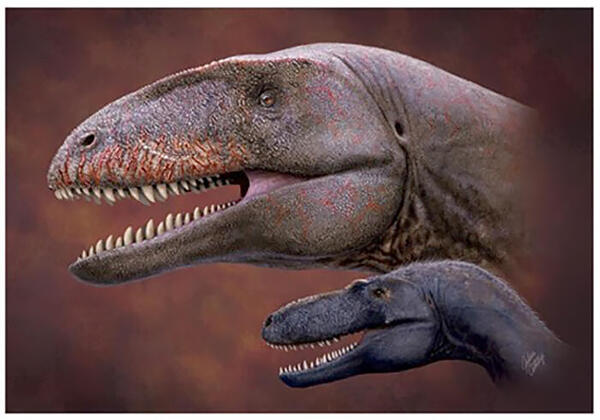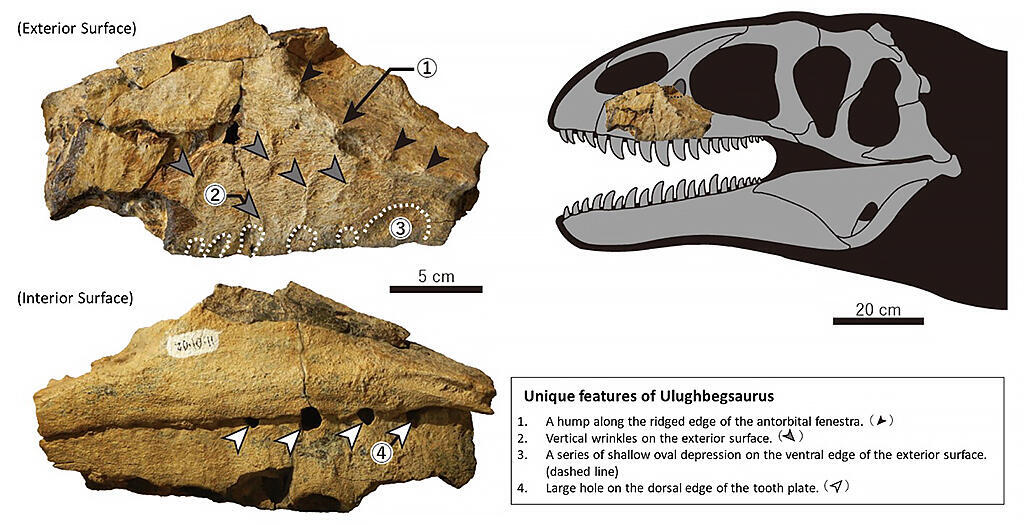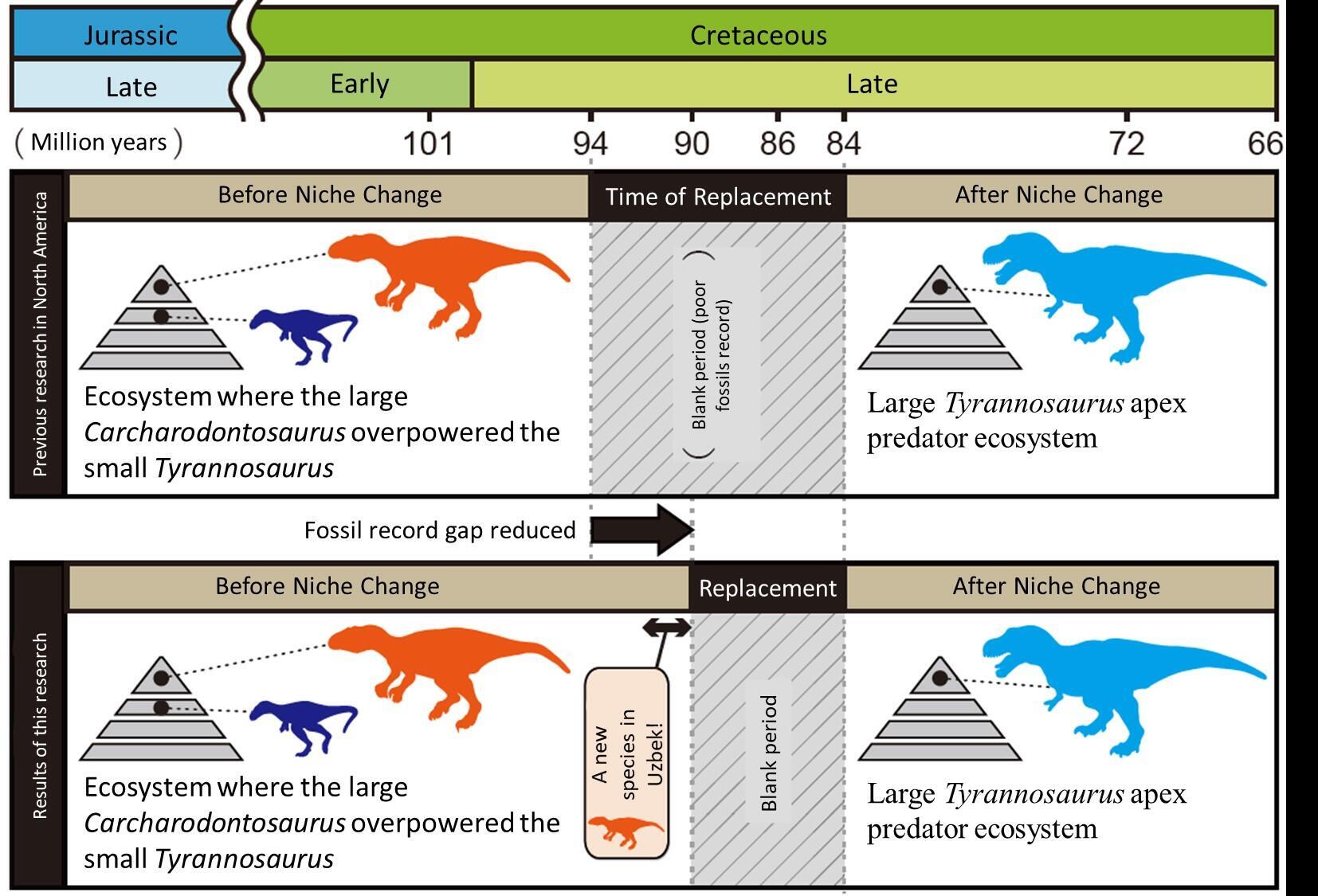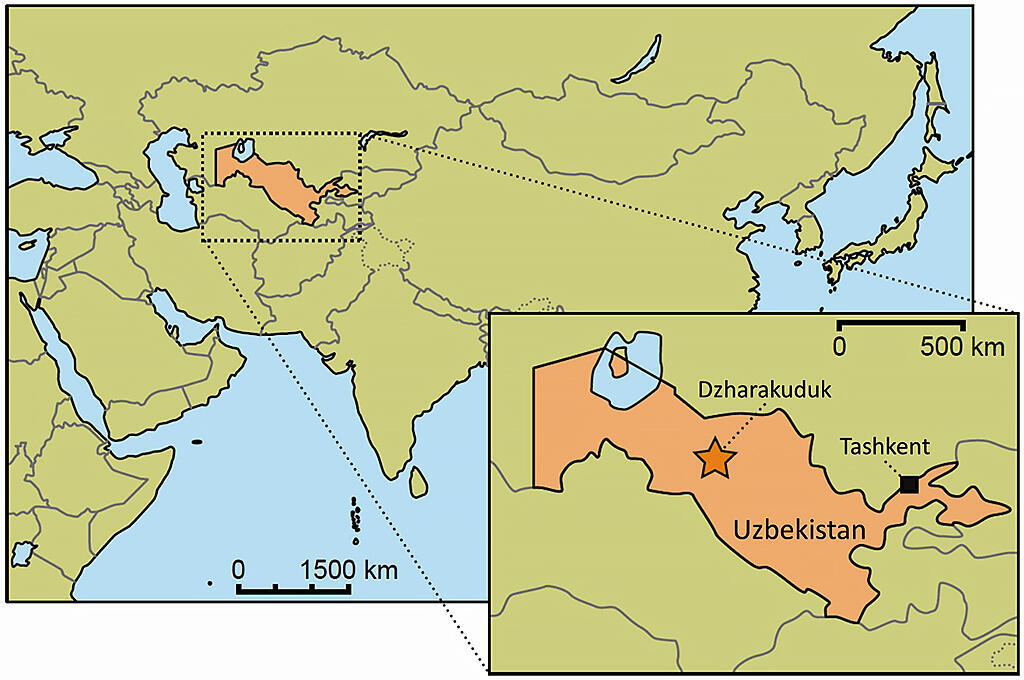Tyrannosaurus, the strongest and largest carnivorous dinosaur in history, is probably the most popular dinosaur in the paleontology world. We are all familiar with its appearance through museums and movies. However, it is said that the last 20 million years of the Cretaceous period, which lasted 80 million years until the extinction of dinosaurs 66 million years ago, was when they became larger and took control of the Earth. Before that, the large carnivorous dinosaur that stood at the top of the ecosystem was the Carcharodontosaurus, a name which you are less likely to be familiar with. It is a mystery why and how the reign of one dinosaur ended and that of the other began.
Under these circumstances, international research groups, such as those from University of Tsukuba and Hokkaido University, have found that fossils found in the Late Cretaceous strata of Central Asia and Uzbekistan are newer species of the Carcharodontosaurus family. A small member of the Tyrannosaurus genus was also found in the strata of the same era, the newest in the world and the first evidence of coexistence between the two in Asia. Researchers are excited to find the piece of the puzzle that can solve the mystery of the switch in positions between the two.

(provided by Julius Csotonyi)
The former king, Carcharodontosaurus
The research group scrutinized some unexplained fossils in the National Geological Museum in Tashkent, the capital of Uzbekistan. The fossil is believed to be the maxilla (the bone from the cheek to the nose), 24 cm long and 13 cm high, found in the stratum dated to around 92 to 90 million years ago, which corresponds to the Late Cretaceous (100 to 66 million years ago). The study result reveals that this fossil is a new species, as it has distinctive surface features like humps, wrinkles, depressions, and holes, absent in other discovered dinosaurs. Furthermore, on phylogenetic analysis of its relationship with known species, it was found to be a member of Carcharodontosaurus.

(provided by University of Tsukuba and Hokkaido University)
Carcharodontosaurus had a maximum length of 13 m. It prospered and reigned as the top of the ecosystem from the Late Jurassic (200-145 million years ago) to the middle of the Late Cretaceous. On the other hand, the Tyrannosaurus family appeared in the Middle Jurassic and was initially small and, for a long period, was overpowered by large dinosaurs. However, when the Carcharodontosaurus disappeared from the Northern Hemisphere, they became larger and prospered instead.
The research group named the new species Ulughbegsaurus uzbekistanensis. The meaning is "Uzbekistan's Ulugh Beg's lizard". Ulugh Beg was a 15th-century mathematician and astronomer, who also became a Timurid sultan.
Based on the discovered related species, it seems that the owner of this bone was 7.5-8 meters long and weighed over a ton. "It has become the largest carnivorous dinosaur found in Uzbekistan," explains Kohei Tanaka, Assistant Professor at the Faculty of Life and Environmental Science, University of Tsukuba (Society of Vertebrate Paleontology).
Narrowing of the mysterious fossil gap - The Ulughbegsaurus
In addition to the significance of discovering a new species, the research group sees many important values attached to the discovery. One is that Carcharodontosaurus, previously reported in the United States, Europe, and the eastern part of Asia in the Northern Hemisphere, was found in the western end of Asia for the first time.
Second, it was the first time in the Late Cretaceous that a Tyrannosaurus was found to coexist with Carcharodontosaurus in the same stratum outside of North America. Timurlengia, a tyrannosaur, is only 3-4 m long and weighs 170 kg. Ulughbegsaurus, with a much larger body, must have reigned as the top of the ecosystem. In Uzbekistan, as in North America, the Tyrannosaurus were likely small, and the Carcharodontosaurus coexisted with them in a dominant position. This is likely to be a clue to solve the mystery of the story of how the two changed places through further research.
This coexistence of both species, which was found in the most recent fossil record, is also extremely important. There is a record of coexistence in North America from 94-96 million years ago, and in from this discovery, the record has been updated to about 2-6 million years more recent than previously thought. The Tyrannosaurus family grew in size for 90-92 million years before the discovery of the large Ulughbegsaurus.
A large Tyrannosaurus, dating back to 84 million years ago, has been found in North America. The last ten million years or so before that was a mysterious gap with no clues from anywhere in the world. The discovery of Ulughbegsaurus was a valuable achievement in narrowing this gap.
Assistant Professor Tanaka says, "It seems that there was competition between giant carnivorous dinosaurs in the Cretaceous period. Although, fossils from the time when the largest Tyrannosaurus unified the world were scarce, we pursued them. This time Ulughbegsaurus serves as proof to fill the knowledge gap."

Discovery of a new species of Carcharodontosaurus in Uzbekistan and narrowing of the mysterious gap in which a change in supremacy to Tyrannosaurus occurred
(provided by University of Tsukuba and Hokkaido University).
The research group consisted of Assistant Professor Tanaka of Tsukuba University, Professor Yoshitsugu Kobayashi of Hokkaido University Museum, and researchers from the University of Calgary, Canada, and the State Geology Museum in Uzbekistan. The results were published in the Royal Society's scientific journal Open Science.
Flipping the script, why did Tyrannosaurus take over?
The research group aims to clarify the competition and evolution status of carnivorous dinosaurs and will continue to conduct research mainly in Asia. Research is still limited, especially in Uzbekistan and even bigger discoveries can be expected in the future.
Regarding the drama involving the hegemonic change between Carcharodontosaurus and Tyrannosaurus, Assistant Professor Tanaka says, "Now we are at the stage of searching for fossils, investigating in what order and at what timing the change of status occurred. We will continue to investigate fossils and fill the gap, even if little by little."
The challenge ahead is determining why the swap or the change in places occurred. Assistant Professor Tanaka says, "At that stage, we will step into the environment of the time and determine what capabilities the dinosaurs had."
The history of the living creatures born around 4 billion years ago is a series of change in supremacy. The case of Carcharodontosaurus handing over the throne to the strongest animal in history, the Tyrannosaurus, is probably one of the biggest events. We will pay attention to solving the mystery of the story of this rise and fall. At the same time, a thought suddenly came to my mind, "Will a creature eventually appear that would take the place of humans? What will be the story of our change in position? What kind of creature will it be?"

(KUSAKA Takeo / Science Portal Editorial Office)
Original article was provided by the Science Portal and has been translated by Science Japan.




